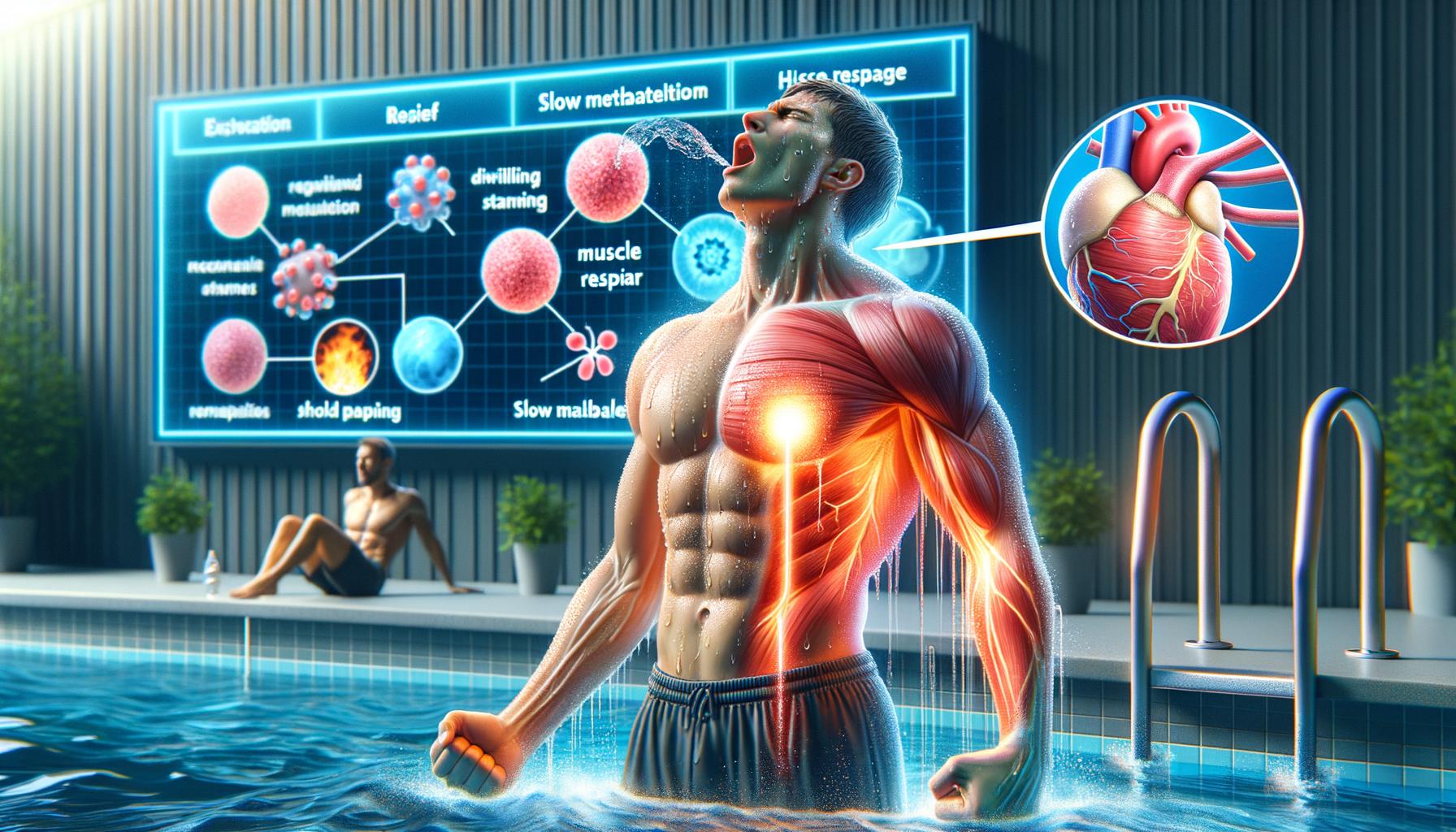· fitness · 16 min read
Cold Water Immersion: Benefits and Drawbacks for Muscle Recovery
Explore the intricate balance between the benefits and potential drawbacks of cold water immersion for athletes and individuals seeking optimized muscle recovery and growth.

In This Post
The Fact Why Should I Care How To Put In Action Start Tomorrow Guide How does it effect my ability to focus How does it impact my daily life How does it help me make friends How does it help me manage stress How does it effect my mood Summary: Remember Refresher Checklist The Full Research Article CitationsPrint Out The Tomorrow Checklist!
Sign up for our newsletter and receive a copy today, so that, you can start tomorrow! Or the next day, or the day after that. I forget everything and starting things is hard at least for me so these checklists are godsend.
Print Out The Remember Refresher Checklist!
Sign up for our newsletter and download your own copy of the Remember Refresher Checklist, so that, you can easily put it on your fridge and help you stay on target towards your WHY. Every little bit helps.
Introduction
Overview of Cold Water Immersion
Cold water immersion (CWI), often referred to as ice baths or cold therapy, is an age-old practice that has recently seen a resurgence within athletic and fitness communities around the globe. It involves the deliberate exposure of one’s body to cold water, typically between 10°C and 15°C (50°F and 59°F), for a set period, usually ranging from 10 to 20 minutes. This practice is rooted in the principle of harnessing the therapeutic properties of cold exposure to aid in muscle recovery, reduce inflammation, and enhance overall physical wellness.
The checklist below outlines the core components of a successful cold water immersion session:
- Appropriate Water Temperature: The water should be within the therapeutic range of 10°C to 15°C.
- Immersion Time: Limit the immersion to between 10 and 20 minutes to maximize benefits and minimize risk.
- Safety Measures: Always ensure supervision or have someone nearby, particularly for individuals new to cold water immersion.
- Post-Immersion Care: Gradual warming and appropriate hydration after immersion help in recovery.
Purpose and Popularity in Sports Recovery
CWI’s popularity in sports recovery is largely due to its purported benefits in easing post-exercise soreness, reducing muscle inflammation, and speeding up the recovery process. Often athletes, ranging from amateur runners to professional sports figures, turn to cold water immersion as a key component of their recovery regime. This trend is also supported by a growing body of sports science research, which explores how CWI might positively impact athletic performance, muscle repair, and recovery timelines after strenuous physical activities.
Moreover, the evolving understanding of body metabolism, cellular processes triggered by cold exposure, and their implications for muscle endurance and performance fuels the growing interest and adoption of CWI across various sports disciplines. As more individuals seek out effective and natural methods to enhance post-exercise recovery and maintain optimal physical condition, CWI stands out as a practice deeply rooted in both tradition and contemporary sports science.
The Science Behind Cold Water Immersion
Understanding Muscle Inflammation and Soreness Post-Exercise
Muscle inflammation and soreness after exertion, commonly known as Delayed Onset Muscle Soreness (DOMS), are indicators of the microscopic damage to muscle fibers incurred during intense or unfamiliar physical activity. This physiological response triggers an inflammatory process, facilitating the repair and strengthening of muscle tissue. Although essential for muscle development, this inflammation can lead to discomfort and decreased athletic performance in the short term. The key to optimizing recovery lies in efficiently controlling this inflammation without completely impeding the muscle repair process.
The Physiological Effects of Cold on the Body
Exposing the body to cold water initiates several physiological reactions. Initially, there’s a sharp constriction of blood vessels, known as vasoconstriction, which reduces blood flow to extremities to preserve core body temperature. Cold exposure also stimulates the autonomic nervous system, leading to the release of endorphins, which can naturally reduce pain and induce a sense of well-being. Additionally, the cold can decelerate metabolic processes and reduce inflammatory responses in the muscle tissues, a crucial factor in the management of post-exercise soreness and inflammation.
How Cold Water Immersion Reduces Inflammation and Soreness
Cold water immersion directly impacts inflammation and muscle soreness through several mechanisms:
- Reduced Blood Flow: The immediate vasoconstriction reduces swelling and blood flow to the affected areas, limiting inflammation.
- Decreased Metabolic Activity: Lower temperatures reduce the metabolic rate of cells, slowing down the inflammatory process and potentially reducing the severity of DOMS.
- Endorphin Release: Cold exposure triggers an analgesic (pain-reducing) effect through the release of endorphins, offering immediate relief from soreness.
Check How Cold Water Immersion Can Be Implemented:
- Gradual Introduction: Begin with shorter durations in slightly cooler water, gradually reducing the temperature and increasing exposure time as tolerance builds.
- Consistency: Regular post-exercise cold water immersion can help in adapting to the sensations and maximizing the therapeutic benefits.
- Water Temperature and Duration: Ideal conditions typically range from 10-15°C (50-59°F) for about 10-15 minutes, but personal preferences and responses can vary.
- Safe Practices: Avoid immediate transition from extreme heat to cold, and always ensure you are in a safe environment to prevent risks associated with cold exposure, such as hypothermia.
The science underpinning cold water immersion presents a compelling case for its effectiveness in managing inflammation and enhancing muscle recovery processes. However, individual responses can vary, and it is crucial to tailor recovery practices to each athlete’s specific needs and conditions. In the next parts, we will explore the benefits and potential drawbacks of incorporating cold water immersion into your recovery regimen to maximize muscle growth and performance while ensuring safety and well-being.
Pros and Cons of Cold Water Immersion
Immediate Benefits: Reducing Inflammation and Soreness
Cold water immersion stands out as a favored recovery method among athletes for its swift action against post-exercise inflammation and soreness. Following a high-intensity workout or competition, the body often undergoes muscle inflammation, a natural response to microscopic damages. This process is crucial for muscle repair but can be associated with discomfort and reduced functional capacity in the short term.
Immersing in cold water prompts several physiological changes. It reduces the temperature of damaged muscle tissues and constricts blood vessels, which significantly decreases metabolic activity and slows down the inflammation process. This action, in turn, helps in reducing the sensation of pain and discomfort, often described as soreness or stiffness, experienced after intense physical activities.
Furthermore, the reduced muscle temperature and blood flow may also diminish the cellular metabolism in the affected muscle areas, thereby restraining further inflammation and swelling. Athletes who practice cold water immersion often report a quicker return to their baseline levels of training performance and a more comfortable post-exercise recovery period.
Potential Drawbacks: Impaired Muscle Growth and Strength
Despite its immediate benefits in managing inflammation and soreness, cold water immersion might not be the optimal choice for every recovery scenario, particularly when considering long-term muscle growth and strength development. Some research indicates that regular use of cold water immersion post-exercise can interfere with the muscle’s repair and adaptation mechanisms — essential for muscle hypertrophy (growth) and strength gains.
The primary mechanism behind this effect involves the blunted hormonal response associated with muscle repair and growth. The cold temperatures can reduce the activity of satellite cells and the synthesis of protein in muscles, both of which are pivotal for muscle repair and growth following resistance training. As a result, athletes engaging in strength training could experience a delay or impairment in hypertrophy and strength improvements over time due to the frequent use of cold water immersion as a recovery strategy.
Navigating the Frequency of Cold Water Therapy
To harness the benefits of cold water immersion without significantly impacting long-term muscle growth and strength, it’s critical to navigate its frequency and timing appropriately. Here’s a checklist for athletes and fitness enthusiasts to consider:
- Evaluate your training goals and phases: Frequent cold water immersion may be more suitable during intense competition periods where immediate recovery is a priority over long-term strength gains.
- Limit the frequency: Opt for cold water immersion sparingly and possibly avoid it during periods focused on muscle hypertrophy and strength training.
- Monitor your response: Keep track of your performance and progress. If you notice a plateau in strength gains, reassess your use of cold water immersion in your recovery routine.
- Personalize your recovery: Remember that individual responses to recovery methods vary. Tailor your use of cold water immersion to fit your specific recovery needs and training demands.
Cold water immersion offers a tangible immediate relief from inflammation and soreness post-exercise, making it an attractive option for recovery. However, its impact on long-term muscle growth and strength development necessitates a balanced and strategic approach to ensure that athletes and fitness enthusiasts can enjoy the best of both worlds.
Cold Water Immersion in Practice
Implementing cold water immersion (CWI) into your post-exercise recovery routine can be highly beneficial if done correctly. To harness the potential benefits of CWI while minimizing the drawbacks, consider the following recommended practices and alternatives.
Recommended Practices for Cold Water Immersion
Adapting CWI into your routine requires a mindful approach to ensure it aligns with your recovery and training goals. Here are some guidelines:
- Start Gradually: If you’re new to CWI, begin with shorter durations and slightly warmer water temperatures. Gradually decrease the water temperature and increase immersion time as you acclimate.
- Temperature and Timing: Optimal water temperatures for CWI typically range from 10°C to 15°C (50°F to 59°F). Immersion times should range from 10 to 15 minutes, based on individual tolerance and experience level.
- Frequency: Incorporate CWI 2-3 times per week after intense training sessions or competitions, adjusting based on how your body responds.
- Focus on Whole Body: While partial immersions can be effective, aiming for whole-body immersion can provide more extensive benefits, particularly for overall soreness and recovery.
- Monitor Your Response: Pay attention to how your body responds both immediately after CWI and in the hours following. Adjust frequency, duration, and temperature based on personal comfort and recovery outcomes.
Here’s a simple checklist to help you integrate CWI into your routine:
[ ] Start with warmer water and shorter immersions, then adjust as you acclimate.
[ ] Aim for water temperatures between 10°C to 15°C (50°F to 59°F).
[ ] Limit immersion to 10 - 15 minutes per session.
[ ] Incorporate CWI into your recovery routine 2-3 times a week, especially after intense sessions.
[ ] Opt for full-body immersion for more comprehensive benefits.
[ ] Regularly evaluate how your body responds to adjust the practice accordingly.
Alternatives to Cold Water Immersion for Muscle Recovery
While CWI offers numerous benefits, it’s not the only recovery method available. Consider these alternatives to diversify your recovery strategies:
- Active Recovery: Low-intensity exercise, such as walking or light cycling, can help reduce soreness and improve blood flow.
- Compression Therapy: Wearing compression garments can enhance circulation and may help in reducing muscle soreness.
- Heat Therapy: Alternating between cold and heat therapy can be beneficial for some athletes, with heat helping to relax muscles and improve blood flow.
- Massage: Therapeutic massage not only alleviates muscle tightness but can also be an effective tool for promoting relaxation and reducing DOMS.
- Foam Rolling: This form of self-myofascial release can improve flexibility and decrease muscle soreness.
Personalizing Your Recovery Process: When to Use Cold Water Immersion
Deciding when to use CWI hinges on understanding your body’s reactions, your training cycle, and your overall health. Consider CWI particularly after highly intense or long-duration sessions where muscle soreness and inflammation are expected to be higher. Additionally, using CWI during competition periods for rapid recovery can be strategically beneficial. However, during phases focused on muscle growth and strength gains, moderating the use of CWI might be prudent due to its potential effects on hypertrophy.
Incorporating CWI as part of a balanced recovery strategy, taking into account personal objectives, health conditions, and responsiveness to various recovery modalities, is crucial. Experimenting under professional guidance and listening to your body will help you ascertain the most effective use of cold water immersion in achieving optimal recovery and performance.
FAQs on Cold Water Immersion for Athletes
How often should athletes use cold water immersion for optimal benefits?
The frequency of cold water immersion (CWI) for athletes seeking optimal benefits is a topic of ongoing research and discussion in sports science. Generally, the consensus leans towards moderation. Here’s why: CWI can significantly reduce inflammation and alleviate soreness, making it an attractive recovery method, especially after intense training sessions or competitions. However, its impact on muscle repair and growth necessitates prudent use.
- Moderation is Key: Engaging in CWI too frequently—such as after every workout—might hinder the body’s adaptive processes essential for muscle strengthening and growth.
- Individual Differences: Athletes should consider personal factors, including their training intensity, current physical condition, and how their bodies respond to cold exposure.
- Recommendation Range: Many experts suggest a balanced approach, recommending CWI 2-3 times a week after particularly strenuous sessions or competitions, to combine benefits of inflammation reduction and support muscle recovery without impairing muscle growth.
- Listen to Your Body: Ultimately, listening to your body and adjusting frequency based on personal recovery needs is crucial.
Can cold water immersion completely replace other recovery methods?
Cold water immersion, while effective in reducing inflammation and soreness, should not be viewed as a standalone recovery solution. Recovery is a multifaceted process requiring a comprehensive approach, including nutrition, hydration, sleep, and other recovery modalities:
- Use as Part of a Holistic Approach: Integrating CWI with other recovery methods like active recovery, massage, and stretching can provide a more comprehensive recovery strategy.
- Limitations of CWI: Sole reliance on CWI might neglect the benefits other recovery aspects offer, like the psychological relaxation from massage or the flexibility improvements from stretching.
What are the long-term effects of regular cold water immersion on muscle development?
While CWI can offer short-term benefits for inflammation and soreness reduction, its long-term effects on muscle development are nuanced. Here are some critical points to consider:
- Potential for Hypertrophy Impairment: Regular, excessive use of CWI might impair the muscle adaptation processes essential for hypertrophy (muscle growth). This impairment could potentially limit long-term gains in muscle size and strength.
- Balancing Recovery and Adaptation: Striking a balance between using CWI for recovery while allowing the body to undergo the natural stress and adaptation cycle is crucial.
- Research is Ongoing: The exact long-term impacts of CWI on muscle development are still under investigation by sports scientists. Individual responses can vary based on frequency, duration, and how CWI is integrated into an overall training and recovery regimen.
Checklist for Athletes Considering Cold Water Immersion:
- Use CWI in moderation, ideally 2-3 times a week after intense sessions
- Combine CWI with other recovery methods for a well-rounded approach
- Monitor personal response to CWI, adjusting frequency and duration as needed
- Stay informed on the latest sports science research regarding CWI and muscle development
- Consult with sports health professionals to tailor a recovery plan that includes CWI appropriately
By keeping these FAQs and checklist in mind, athletes can make informed decisions about integrating cold water immersion into their recovery routines, optimizing its benefits while minimizing potential drawbacks for muscle development.
Conclusion
Summarizing the Importance of Balanced Cold Water Immersion Use
Cold water immersion has emerged as a popular post-exercise recovery technique embraced by athletes and fitness enthusiasts alike. Its surge in popularity is backed by its immediate benefits, most notably inflammation reduction and soreness alleviation following strenuous physical activities. These effects stem from the physiological responses of the body to cold exposure, which includes decreased blood flow to areas of inflammation, reduced cellular metabolism, and an overall numbing sensation that provides temporary relief from pain.
However, as with many recovery methods, the significance lies in its balanced and informed use. Over-reliance on cold water immersion, especially immediately after strength training, can potentially impair muscle growth and strength gains. This is attributed to the inhibition of cellular processes essential for muscle repair and hypertrophy. Therefore, integrating cold water immersion into a recovery routine requires a nuanced understanding of its effects and the best timing for its application to optimize benefits while minimizing drawbacks.
Navigating the use of cold water immersion involves an appreciation for the multiple facets of post-exercise recovery and the body’s natural healing processes. For athletes and individuals engaged in regular intense physical activities, considering the following checklist could help in achieving a balanced approach to cold water immersion:
- Understand the Immediate Benefits: Recognize that cold water immersion is effective for reducing immediate post-exercise inflammation and soreness.
- Consider the Potential Drawbacks: Be aware that frequent and immediate post-exercise cold water immersion may interfere with muscle growth and strength development.
- Personalize Your Recovery Routine: Tailor the use of cold water immersion based on individual training schedules, fitness levels, and recovery needs.
- Incorporate Alternative Recovery Methods: Combine cold water immersion with other recovery techniques like active recovery, massage, or heat therapy for a holistic approach.
- Listen to Your Body: Pay attention to how your body responds to cold water immersion and adjust frequency and duration accordingly.
- Stay Informed: Keep abreast of the latest research and guidelines on recovery techniques to make informed decisions about including cold water immersion in your regimen.
In conclusion, cold water immersion remains a valuable tool in the athlete’s recovery arsenal when used judiciously. Its benefits in terms of reducing soreness and inflammation can significantly enhance post-exercise recovery. Still, it’s vital to maintain a balanced perspective and integrate cold water immersion as part of a broader, more holistic approach to recovery. This ensures the optimization of both immediate and long-term athletic performance, making the journey towards fitness goals more sustainable and rewarding.
3 Relevant External Links
In the realm of cold water immersion, a plethora of resources is available for athletes, fitness enthusiasts, and coaches aiming to deepen their understanding of the technique and its various effects on muscle recovery and athletic performance. Here are three pivotal resources that offer comprehensive insights into the world of cold water immersion and recovery methods.
American College of Sports Medicine Recovery Techniques
For those looking to integrate scientifically backed recovery techniques into their training regimen or those of athletes they coach, the ACSM provides guidelines that are considered gold standards in the fitness and sports community. Their recommendations on cold water immersion among other recovery strategies offer invaluable insights.
Nature Research on Cold Water Immersion Effects
This detailed scientific study delves into the physiological impacts of cold water immersion, offering evidence-based findings that can help individuals weigh the benefits and drawbacks. For anyone seeking to understand the intricate mechanics of how cold water immersion affects inflammation, soreness, and muscle recovery from a scientific perspective, this resource is indispensable.
Healthline: Benefits of Cold Showers
While focused more broadly on the benefits of cold exposure, Healthline’s article provides an accessible entry point for those curious about incorporating cold therapy into their routine for its recovery benefits and beyond. It’s an excellent resource for understanding the potential wellness and mental health benefits.
Making the Most of These Resources
To effectively utilize the wealth of information provided in these resources, here’s a checklist to guide you through integrating cold water immersion into your recovery regimen:
- Read through the ACSM Guidelines on Recovery Techniques to align your recovery practices with current sports science recommendations.
- Deep dive into the Scientific Study on Cold Water Immersion to understand the biological and physiological responses your body has to cold water immersion.
- Explore the Healthline article on the Benefits of Cold Showers for a broader understanding of cold exposure benefits, complementing your cold water immersion practice.
- Personalize Your Recovery Strategy based on insights gained from these resources, factoring in your training intensity, personal goals, and how your body responds to cold water immersion.
- Consult with a Healthcare or Fitness Professional if you’re new to cold water immersion, especially to ensure it aligns with your overall health and fitness objectives.
By leveraging these resources, individuals can make informed decisions regarding cold water immersion and how it fits within a holistic approach to recovery and performance enhancement. Whether you’re an athlete, coach, or fitness enthusiast, understanding the science and methodology behind cold water immersion will empower you to optimize your recovery processes and athletic achievements.
- cold-exposure-therapy
- cryotherapy
- post-exercise-recovery
- muscle-repair
- hypertrophy-impairment
- blood-flow-and-metabolism
- athletic-performance
- inflammation-reduction
- soreness-alleviation
- strength-training
- body-metabolism
- cellular-processes
- muscle-growth
- recovery-methods
- sports-science
- physical-therapy
- delayed-onset-muscle-soreness-doms
- therapeutic-cold-application
- exercise-physiology
- muscle-endurance





